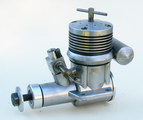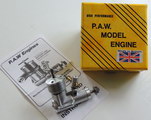|
|
The vast number of diesel model airplane engines that have come from the proflific manufacturers on the continent of Europe atest to the overwhelming popularity of that branch of the ignition engine world. Small, of varying degrees of design from downright ugly to rather eyecatching and handsome, they have sprouted from country to country during the past 50 plus years. No country has produced more than the United Kingdom where they reign supreme.
Fourty some years ago the brothers Eifflaender, Gig and Anthony, started the PAW line of engines from their Progress Aero Works, Park Mill, Hobson Street in Macclesfield, England. Today they are the largest diesel model engine manufacturers in the world. During this time, progressive development has kept them to the forefront of top-class sport engines with many competition successes. Their engines are all "over square" short stroke beauties. The P.A.W. 29, one of their most popular units is the subject of this article.
Designed by Tony Eifflaender, for control line use, the 29's popularity has extended into the very natural area of vintage model flying. All P.A.W.s are designed alike in the style with strong functional appearance. The aluminum alloy crankcase comes with the wide and lengthy supportive bearing lugs, with a hardened steel crankshaft running directly in the plain bore bearing of the casing. The good lubricating quality of diesel fuels enhances the lifespan of this method. The short rugged crank itself has heavily radiused intersections between crankpin, web and mainshaft, contributing markedly to PAW reliability. The hardened steel liner has a substantial wall thickness with four equally spaced exhaust ports.
Similarly there are four transfer passages/ports (internally milled within the liner walls.) The grey cast iron piston has a flat top. The connecting rod is of high duty aluminum alloy and no lubrication holes are provided. The cylinder fins and cylinder are aluminum alloy turnings, which accept four long screws which clamp head, fins, liner and crankcase firmly together. The contrapiston, is cast iron and a flat annular shape to match the chamber. The carburetor is also an aluminum turning with brass R/C throttle. Idle control is by a small hole air bleed with a normal adjustable throttle stop provided. The silencer is an aluminum casting and is effectively simple fitting and very positioning flexible.
Eifflaender has in production a full line of these remarkable diesel engines and sells world wide. From the 0.8cc (.049), 1.0, 1.5, 2.5, 3.22 to the recently released huge .60 all are factory run, giving starting positions of controls, prop used, plus any peculiarity of that particular engine. They throttle very well and are fully guaranteed against faulty workmanship. These beautifully made diesels are not what the collectors of diesels are after at this stage in their manufacturing and development. But they are the best looking and best running of the compression ignition engines on the market and priced remarkably affordable. Eric Clutton, that lively displaced Britisher at 913 Ceder Lane in Tullahoma, Tennessee sells and swears by them.
 Back to Model Engine News Home
Back to Model Engine News Home
Back to Janson Index
Please submit all questions and comments to [email protected]


